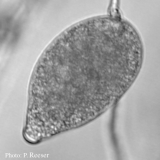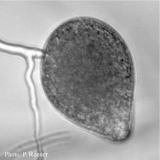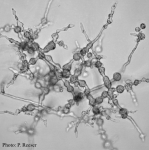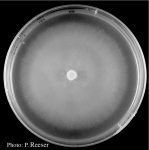Phytophthora pluvialis
Phytophthora pluvialis Reeser, Sutton, and E. Hansen was first discovered in streams, soil, and raintraps in Curry County, Oregon, USA, in areas dominated by native forest of mixed tanoak and Douglas-fir (Reeser et al., 2013). On rare occasions it was isolated from lesions on tanoak bark or twigs, but was only weakly pathogenic when inoculated into tanoak stems. In New Zealand, Phytophthora pluvialis was found to cause red needle cast on radiata pine (Dick et al., 2014). In Oregon the species is now associated with Douglas-fir, and experimentally has been shown to cause needle cast and twig cankers on seedling trees, both artificially inoculated and exposed beneath the canopy of Douglas-fir plantations (Hansen et al., 2014). The pathogen has not been associated with canker formation or infection of the harvested stem of radiata pine (Hood et al., 2014).
Sporangia (average 53–67 μm by 39–45 μm) formed in water, ovoid or slightly irregular (occasionally bifurcate), semi-papillate, terminal or sub-terminal on simple or sympodial sporangiophores. Sporangia are partially caducous with variable, medium length (5–22 μm) pedicels. Hyphal swellings formed in water are globose and intercalary with radiating hyphae forming loose networks. Hyphal swellings formed in agar are variable. Oogonia (average 27 μm to 34 μm), formed in single agar culture, globose, smooth, terminal with amphigynous antheridia. Oospores (average ca. 27–29 μm), globose, aplerotic.
Phytophthora pluvialis resides in ITS Clade 3 (Cooke et al., 2000) along with P. ilicis Buddenhagen & Young, P. nemorosa E.M. Hansen & Reeser, P. pseudosyringae T. Jung & Delatour, and P. psychrophila T. Jung & E.M. Hansen. It is readily distinguished by ITS DNA sequence from related species in Clade 3.
The colony pattern on carrot agar is angular and petaloid, with hyphae appressed. Radial growth rate on carrot agar is about 1.2–1.4 mm/d at 15°C. Temperature optimum was ca. 15°C, min. < 5°C, max. ca. 25°C.
P. pluvialis is most readily recognized by its semi-papillate sporangia, amphigynous antheridia, and distinctive hyphal swellings formed both in agar and in water. It is most similar to P. nemorosa, but growth rate of P. pluvialis at optimum temperature is much slower.
For more information about Phytophthora pluvialis, visit our Disease, Education and Management materials, and Reference sections.









